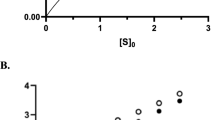Abstract
THE velocity, ν
9 of reactions which exhibit general acid-base catalysis in carboxylate buffers is generally assumed to conform to the equation :  where the various catalytic constants, k, are differentiated by their subscripts. However, Dawson and Spivey1 reported in 1930 that the quantitative description of the rate of enolization of acetone, as measured by its iodination in acetate buffers, required an additional cross-term k
x[HA][A−]. The experimental result was substantiated in 1953 by Bell and Jones2, who also found similar cross-terms, which may account for up to 20 per cent of ν, for trimethylacetate and glycollate buffers. These data are widely considered to be the sole evidence3,4 for the occurrence in aqueous solution of a catalytic mechanism, which requires the simultaneous presence of an acid and a base in the transition state complex. The process has been variously described3,4 as ‘concerted’, ‘synchronous’, ‘push-pull’, ‘ternary’ (with reference to the hypothetical number of species in the transition state) and ‘bimolecular’ (with reference to the hypothetical number of catalytic molecules).
where the various catalytic constants, k, are differentiated by their subscripts. However, Dawson and Spivey1 reported in 1930 that the quantitative description of the rate of enolization of acetone, as measured by its iodination in acetate buffers, required an additional cross-term k
x[HA][A−]. The experimental result was substantiated in 1953 by Bell and Jones2, who also found similar cross-terms, which may account for up to 20 per cent of ν, for trimethylacetate and glycollate buffers. These data are widely considered to be the sole evidence3,4 for the occurrence in aqueous solution of a catalytic mechanism, which requires the simultaneous presence of an acid and a base in the transition state complex. The process has been variously described3,4 as ‘concerted’, ‘synchronous’, ‘push-pull’, ‘ternary’ (with reference to the hypothetical number of species in the transition state) and ‘bimolecular’ (with reference to the hypothetical number of catalytic molecules).
This is a preview of subscription content, access via your institution
Access options
Subscribe to this journal
Receive 51 print issues and online access
$199.00 per year
only $3.90 per issue
Buy this article
- Purchase on Springer Link
- Instant access to full article PDF
Prices may be subject to local taxes which are calculated during checkout
Similar content being viewed by others
References
Dawson, H. M., and Spivey, E., J. Chem. Soc., 2180 (1930).
Bell, R. P., and Jones, P., J. Chem. Soc., 88 (1953).
Swain, C. G., Di Milo, A. J., and Cordner, J. P., J. Amer. Chem. Soc., 80, 5983 (1958).
Bell, R. P., “The Proton in Chemistry” (Methuen, London, 1959).
Bell, R. P., “Acid-Base Catalysis” (Clarendon Press, Oxford, 1941).
Pedersen, K. J., J. Phys. Chem., 38, 590 (1934). Swain, C. G., J. Amer. Chem. Soc., 72, 4581 (1950).
Martin, D. L., and Rossotti, F. J. C., Proc. Chem. Soc., 60 (1959) ; Chem. Soc. Special Publication, No. 13, 182 (1959).
Martin, D. L., and Schlyter, K. ; Martin, D. L., and Rossotti, F. J. C. (to be published).
Carson, J. D. E., Clarke, J. J., and Rossotti, F. J. C. (to be published).
Rossotti, F. J. C., in “Modern Coordination Chemistry”, edit. by Lewis, J., and Wilkins, R. G. (Interscience, New York, 1960).
Katchalsky, Eisenberg H., and Lifson, S., J. Amer. Chem. Soc., 73, 5889 (1951). Cartwright, D. R., and Monk, C. B., J. Chem. Soc., 2500 (1955). Nash, G. R., and Monk, C. B., ibid., 4274 (1957).
Bell, R. P., and McCoubrey, J. C., Proc. Roy. Soc., A, 234, 192 (1956).
Rossotti, F. J. C., J. Inorg. and Nuclear Chem., 1, 159 (1955). Rossotti, F. J. C., and Rossotti, H. S., “The Determination of Stability Constants”, Chapter 14 (McGraw-Hill, New York) (in the press).
Author information
Authors and Affiliations
Rights and permissions
About this article
Cite this article
ROSSOTTI, F. The Concerted Mechanism in Acid-Base Catalysis. Nature 188, 936–937 (1960). https://doi.org/10.1038/188936a0
Issue Date:
DOI: https://doi.org/10.1038/188936a0
Comments
By submitting a comment you agree to abide by our Terms and Community Guidelines. If you find something abusive or that does not comply with our terms or guidelines please flag it as inappropriate.



